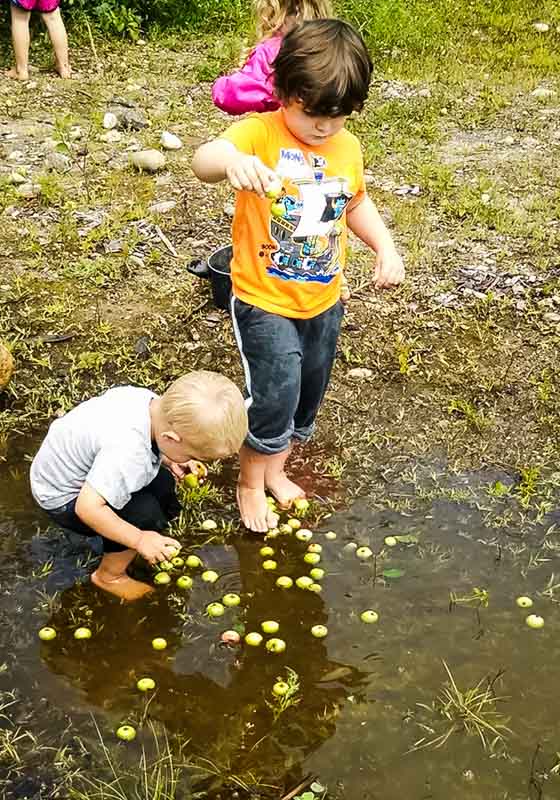The practice of immersing children in nature from an early age has long been popular in the Scandinavian countries, not the least through the tradition of “forest schooling.” Now the concept of learning in nature is finally starting to catch on in the U.S. And with good reason – for young children, the benefits of forest school are both plentiful and profound!
The original Scandinavian forest schools are preschools and day cares where children spend most of their day outside, every day, regardless of the weather. Unlike most American preschools, the focus of this type of early education is not to teach academic facts, but to give kids the opportunity to play freely in nature.
There are no behavior charts, curriculums, worksheets, letter writing exercises or word walls, and the activities are child-centered. The teachers view themselves as “co-discoverers” and guides who explore and experience nature alongside the children.

Photo courtesy of Inch by Inch Preschool.
What are the benefits of forest school?
If you think that this sounds like a lot of fun, but secretly wonder if the kids actually learn anything, then keep reading. In the age of kindergarten readiness and standardized testing gone wild, forest schools offer an opportunity to build important physical, social, cognitive and life skills that pave the way for academic learning later on.
While the children are regularly exposed to traditional disciplines like science, math, physical education, literature, and art, all learning happens organically through inquiry and direct experience, rather than teacher-led lesson plans in a classroom. This gives the preschoolers a chance to do what they really excel in – learn through play.
“Outside, in real life, is where humans learn best,” writes Anders Szczepanski, a Swedish outdoor learning expert. “That’s where we make use of all of our senses by seeing, listening, feeling, smelling, tasting and discerning. It fosters curiosity, creativity and cooperation, engages our emotions and makes us care about our environment, as well as our natural and cultural history.”
Letting children learn primarily in nature also makes perfect sense when you consider the many benefits of outside play that are backed by science. Specifically, studies have found that children who are enrolled in forest schools:
- Are less likely to come down with common infections, since they spend little time inside, where viruses and bacteria thrive (Grahn, 1997)
- Have better motor skills, such as agility, balance and coordination (Fjortoft, 2014)
- Engage in more imaginative and dynamic forms of play (Mårtensson, 2004)
- Are less likely to be overweight or obese (Boldemann et al, 2005)
- See improvements in confidence, social skills, language and communication, motivation and concentration (O’Brien, 2007)
- Become more resilient (Blackwell, 2015)
- Are less likely to experience ADHD symptoms (Isted, 2013)

Photo courtesy of Inch by Inch Preschool
Meanwhile, forest school teachers report that outdoor learning boosts problem-solving and critical thinking skills. They also believe it helps children figure out how to respond to challenges, overcome fears, and work with others – skills that are transferable to the classroom and help the students become successful later in life.
Forest schools are located around the globe
Forest schools originated in Denmark in the 1950s. Sweden followed suit in the 1980s, and since then they have popped up all over the globe under different names – waldkindergarten in Germany, bush kindy in Australia, and nature preschools or forest kindergartens in the U.S.
As recently as ten years ago, there was only one forest school in the U.S., Cedarsong Nature School on Vashon Island in Washington state. Today, there are over 200 nature-based preschools in the United States, according to the Natural Start Alliance. Not all of them are true Scandinavian-style forest schools, but all recognize the role of nature and outdoor play in early childhood.
Despite this growth, forest schools are still a long way from being available to everybody, as onerous regulations and the risk of litigation make it extremely difficult to start forest schools in some states. Hopefully, this will begin to change as more and more parents and teachers are starting to appreciate the power of learning in nature.
The good news is that you still have a lot of options if you want to incorporate forest school principles in your child’s life. Nature-based homeschooling curricula are becoming more and more commonplace, and many families join family nature clubs or play groups to give their children positive experiences in nature. And trust me, the more time you let your kids play freely in nature, the less likely you are to ever wonder about the benefits of forest school.
Suggested reading on the benefits of forest school
Dirty Teaching: A Beginner’s Guide to Teaching Outdoors, by Juliet Robertson
Forest Kindergartens: The Cedarsong Way, by Erin Kenny
Nature Preschools and Forest Kindergartens, by David Sobel
Play the Forest School Way: Woodland Games and Crafts for Adventurous Kids, by Peter Houghton
- The Case for Delaying Screen Time for Kids - November 10, 2017
- 5 Outdoor Mindfulness Activities for Preschoolers - July 31, 2017
- 5 Ways to Avoid Having Too Many Toys - June 5, 2017


Hi I work at a nature center but their are still a lot of old preschool expectations with work sheets but I am trying really hard to change the old way of thinking.
I think the forest school approach is still considered pretty radical in many early childhood education settings and old habits die hard. Good for you for trying to change the old order:o)